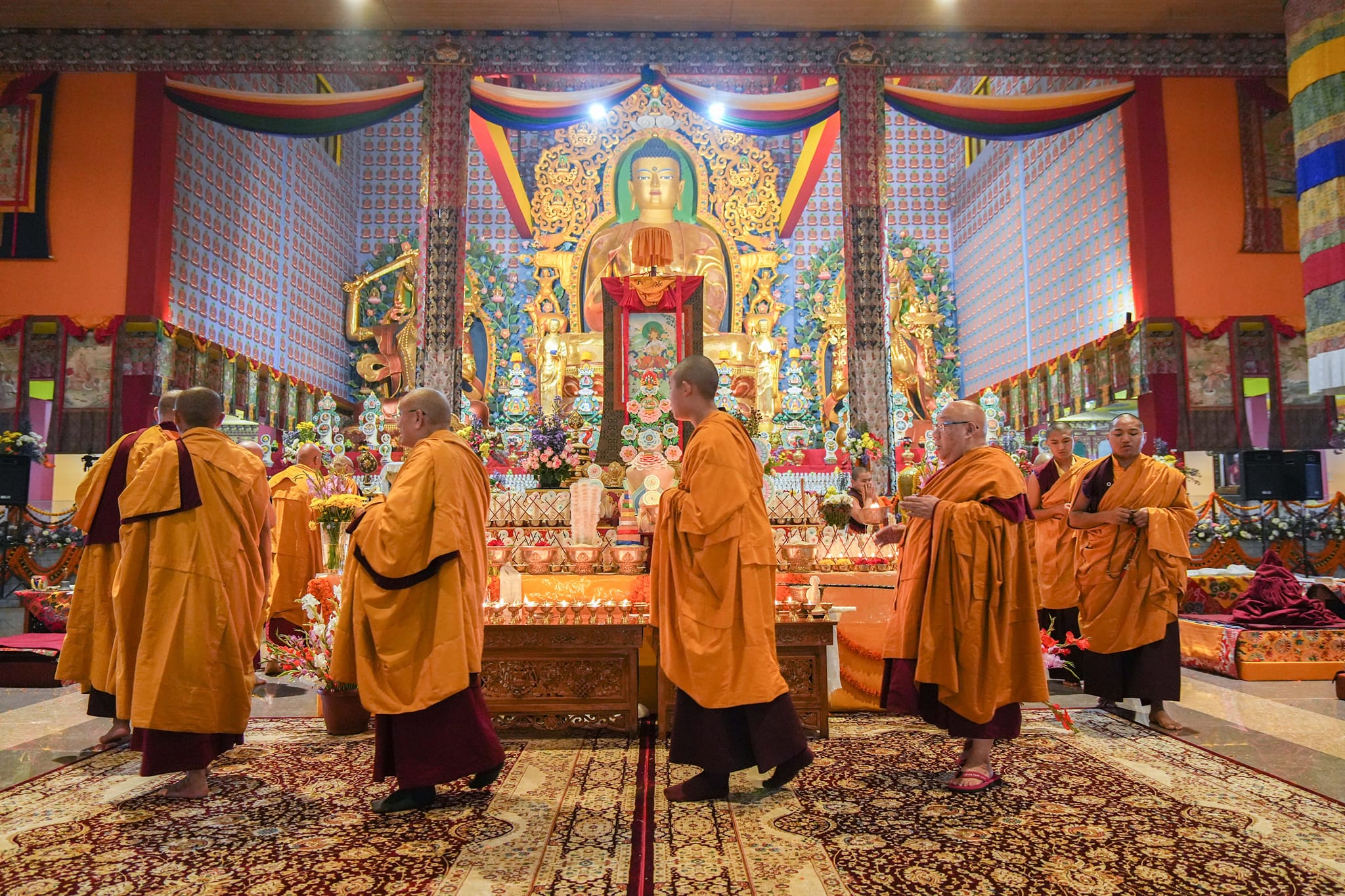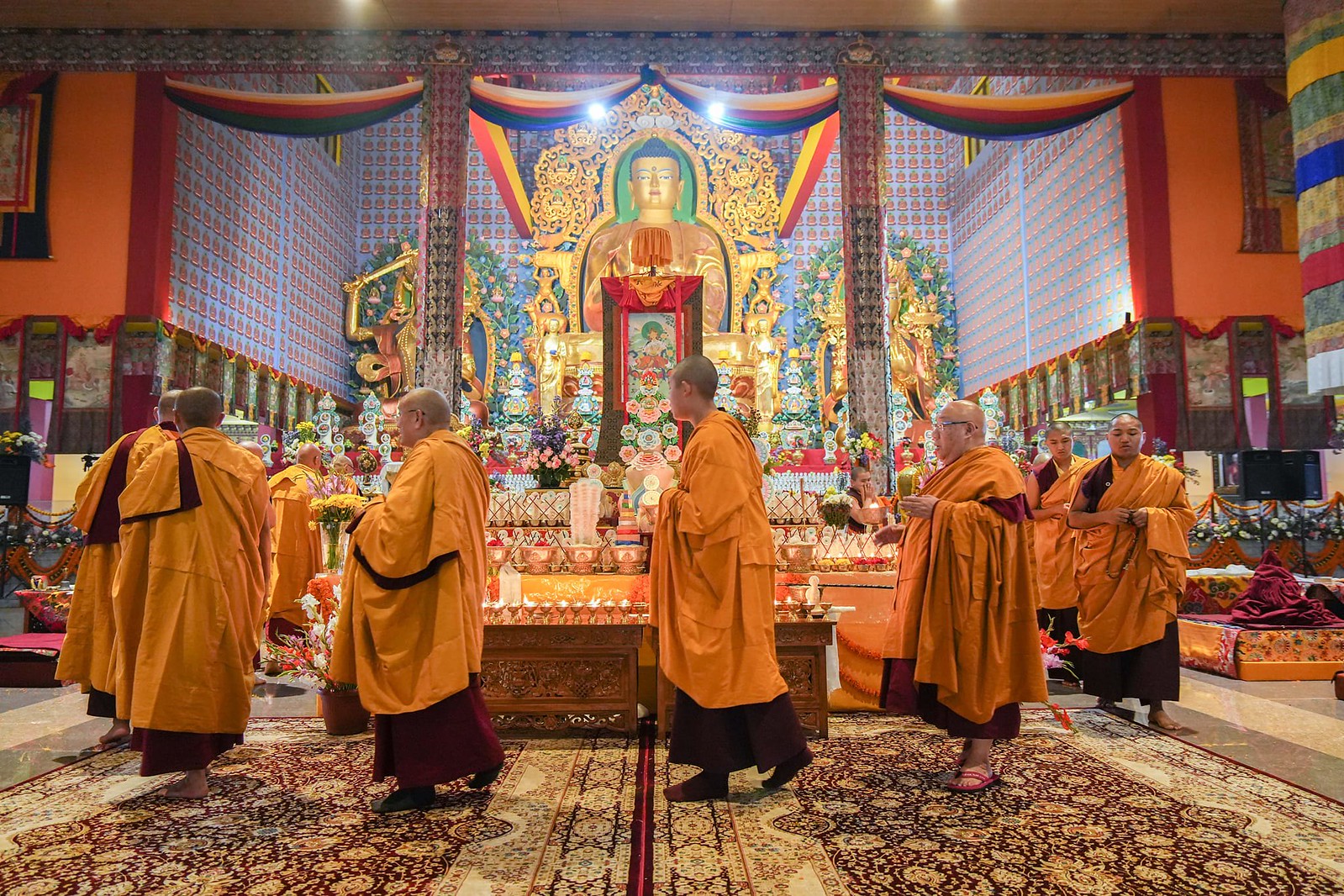Special Kagyu Monlam Day 8
5 February 2023
This was the second of the five sets of five-deity mandala practices that the Gyalwang Karmapa has reintroduced this year. It follows the Five-Deity Hayagriva practice offered during the Kagyu Gunchoe. In total, there are five rituals, and the Karma Kagyu tradition of performing these rituals originated with First Karmapa, Dusum Khyenpa. Each set features a principal deity with four other deities represented in the mandala; the five principal deities are Hayagriva, Chakrasamvara, Vajravarahi, Hevajra, and Tara.
A new shrine had been set up in the shrine hall for the ritual. A thangka of Green Tara of the Acacia Forest hung above it. On the top tier of the shrine were five mandala offerings, four for the other deities and Tara's mandala offering placed centrally. Vases of flowers decorated each corner. On the lower tiers were one large elaborate torma, many rows of shalse [small tormas], a large butter lamp and bowls for the seven traditional offerings. A separate table held small butter lamps. These all formed part of the thousand-fold offering.
Before the ritual began, the Gyalwang Karmapa gave a short introduction. He explained that the Five-Deity Tara practice comes from the tradition of Nagarjuna. It was passed down from Nagarjuna in an unbroken transmission to First Karmapa Dusum Khyenpa. The Five-Deity Hayagriva ritual, which was performed at the Kagyu Gunchoe, may well have been practised up to the time of the Tenth Karmapa, but not from that time, the Karmapa explained, and the Kagyu Gunchoe was probably the first time it had been practised since then by a large gathering of the sangha together. Two of the five-deity rituals survive and are still practised within the Karma Kamtsang: the Five-Deity Chakrasamvara and the Five-Deity Vajravarahi. However, the practice of the Five-Deity Hevajra, the Five-Deity Tara, and the Five-Deity Hayagriva had been more or less lost. They had declined significantly. "It's probably even difficult to hear the words, or any mention of them," he observed, and then explained how crucial it was to revive them. Otherwise, when questioned by other lineages about Dusum Khyenpa's Five Sets of Five-Deity Practices, Karma Kamtsang monks would be unable to answer.
The Karmapa noted that the full text for the ritual to be performed today was not yet complete because it required further annotations and a commentary. Other work demands had prevented him from completing these. However, the ritual text itself was fully prepared and could be recited. This would be auspicious and make a good connection with the practice for the future. Then, at the Arya Kshema Spring Teachings, it might be possible to recite it with the nuns, and so in that way, the entire practice would be restored. He also promised to give the oral transmission for the practice at that point.
He informed everyone that the Five-Deity Tara ritual to be performed was based on the practice of the Green Tara of the Acacia Forest in the Chig Shes Kun Drol (Knowing One Frees All) of Ninth Karmapa Wangchuk Dorje.
His Holiness gave the initiations for the peaceful deities of this cycle during the Kagyu Monlam Chenmo in 2014, and Green Tara of the Acacia Forest with Five Deities was one of those initiations. At that time, His Holiness described how Tara arose from the tears of the noble Avalokiteshvara who was distraught at the suffering of sentient beings because, however many activities he performed, the number of beings in samsara was never reduced. As two of these tears fell on the ground, one became White Tara and one became Green Tara. The two Taras promised to help him perform his activities to benefit sentient beings. The tradition of Green Tara of the Acacia Forest comes from Nagarjuna, who was meditating in an acacia forest when Tara appeared to him. He requested Tara to benefit sentient beings and she agreed. He built a temple for her there, which she herself blessed and consecrated. Consequently, all those who practised there could achieve the ordinary siddhis very quickly. Out of compassion for people who lived far away from the sacred place, Nagarjuna composed the sadhana of Green Tara of the Acacia Forest. Later this tradition was passed down to Dusum Khyenpa, and became one of his five sets of five meditational deities. It became part of the Kamtsang lineage of realisation at the time of Ninth Karmapa Wangchuk Dorje.
So, the Karmapa clarified, the basis for the ritual to be performed today was the sadhana included in the Ninth Karmapa's Chig Shes Kun Drol. He mentioned other forms of the practice, including several pieces from the Indian tradition to be found in the complete works of Dusum Khyenpa. However, there was no complete ritual, and the Karmapa's intention had been to compile one. This involved not just preparing the ritual but adding aspects such as offering four mandalas, instructions on how to recite the Homage to the Twenty-One Taras, and the thousand-fold offering. He explained that such rituals as this were relatively rare, although a few existed in the Gelugpa tradition.
Today’s ritual was the extensive practice, but as a usual practice, it was optional to offer all four mandalas or make the thousand-fold offering. Those who wished to do this as a daily practice need only do the self-visualisation. If they wished to have a more extended practice, they should add the four mandala practice. Finally, the Karmapa suggested that, in future, it would be good for those practising the four mandala Tara practice to do it with the five-deity Tara. Should they want to add the thousand-fold offering, they could.
The details of the four mandala offerings and the thousand-fold offering became more apparent during the puja. Each of the mandala offerings included a set of seven prostrations, the seven branch offerings, the mandala, and the request for one's wishes. To accumulate the thousand-fold offering, in addition to the offerings on the shrine, the ritual includes a passage with offerings of water and the five enjoyments plus music, repeated 21 times at the beginning of the third session. Performed by an assembly of more than a thousand monks, nuns and laypeople, the offerings far exceeded the required number.
Click on the photo to view Flickr picture gallery ↓



































